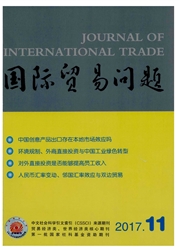

 中文摘要:
中文摘要:
文章首先基于GTAP数据库构建了GTAP-MRIO模型,对2004-2011年期间中国对外贸易的碳排放转移效应进行实证评估。结果发现,研究期间中国为了满足外国最终需求引致大量碳排放净转入,且中国净转入排放主要流向美、欧、日三大发达经济体,凸显"发达国家消费与中国污染"的典型事实。其次,进一步利用GTAP-E模型对未来贸易自由化进程对中国的宏观经济以及碳排放的潜在影响进行预测模拟,结果表明,"多边贸易自由化"对全球的低碳经济发展更为有利,将导致世界各主要经济体(欧盟除外)的碳排放强度下降。对中国而言,"单边贸易自由化"和"多边贸易自由化"将导致中国经济总量和碳排放同步增加,碳排放强度维持基本不变,比较而言,参与"多边自由化"对中国的贸易条件改善、实际GDP增长和消费者福利改善更为有利;而"多边贸易自由化+TPP+TTIP"对中国构成了明显的贸易歧视,导致中国贸易条件和消费者福利显著恶化,经济总量明显下降的同时碳排放总量及碳排放强度均上升。
 英文摘要:
英文摘要:
Firstly, this paper constructs a GTAP-MRIO model to evaluate China's carbon emission transfer through trade, and it finds that during 2004-2011 China is the country with net inward-transferredcarbon emissions. Besides, China's inward-transferred emission is mainly induced by the final demand of the United States, Europe and Japan, highlighting the fact that consumption in developed countries but pollution in China. Secondly, combined with the trend of trade liberalization, we design three different trade liberalization policies. Finally,we use GTAP-E model to predict the potential impact of different trade liberalization policies on the economy and carbon emissions. It finds that "Multilateral Liberalization" is more favorable to the development of low-carbon economy in China and the whole world. Specifically,"unilateral liberalization"and"multilateral liberalization"would increase China's real GDP and carbon emissions, and decrease China's carbon emission intensity gradually. However, "multilateral liberalization + TPP + TTIP" would lead China's real GDP to decline, and China's carbon emissions and carbon emissions intensity rise.
 同期刊论文项目
同期刊论文项目
 同项目期刊论文
同项目期刊论文
 期刊信息
期刊信息
